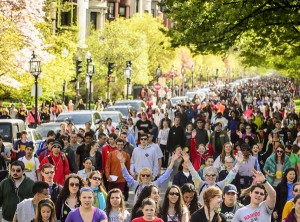 With these divisions so deeply ingrained within our cognitive understanding of the world, it is sometimes difficult to remember that these lines that divide up the world aren’t much more than what they appear to be: ink on paper. The interesting part about this ink on paper is that the ink was probably made in a completely different place than the paper; and the cartographer using the ink and paper sits on a wooden chair made in another chunk of land altogether. What the ink, paper and wood ultimately represent, then, is the people of the world whose needs brought them into existence: people, who, despite the divisions that separate them, partook in the shared experience of living on this planet and subsisting on its resources.
With these divisions so deeply ingrained within our cognitive understanding of the world, it is sometimes difficult to remember that these lines that divide up the world aren’t much more than what they appear to be: ink on paper. The interesting part about this ink on paper is that the ink was probably made in a completely different place than the paper; and the cartographer using the ink and paper sits on a wooden chair made in another chunk of land altogether. What the ink, paper and wood ultimately represent, then, is the people of the world whose needs brought them into existence: people, who, despite the divisions that separate them, partook in the shared experience of living on this planet and subsisting on its resources.
Because the world gradually became bigger and more divided than it once was, it became easy for people to lose sight of the bigger picture. While words like “pollution,” “climate change” and “fossil fuels” began to pop up in the world’s vocabulary, they were written off as far-fetched, too conceptual to truly materialize. When they did begin to materialize, the first instinct was to worry. After all, the world is so much bigger than the people who consume its resources.
The good thing about all this worrying, though, is that it has given rise to awareness. There is a desire to change things, and the citizens of the world are beginning to take things into their own hands. In the coffee shop down the road, a teenager is doing her part by getting her morning coffee in a reusable mug. On the other side of the world, someone is picking up an abandoned newspaper from a London Underground train and putting it in a recycling bin. Somewhere else in the world, a mother is picking up a candy wrapper from the sidewalk and admonishing her little boy for failing to throw it in a trash can. And this past Sunday, thousands of volunteers walked for Project Bread’s Walk for Hunger, raising thousands of dollars towards hunger in Massachusetts.
According to Project Bread’s website, this annual walk has made ending hunger in Massachusetts a goal within reach. The simple gesture of walking has, year after year, had far-reaching consequences for schools and communities in Massachusetts. And if walking can spread the message and make a difference, so can the reusable mug, the recycle bin, the moralizing mom. Big change is ultimately a culmination of little steps towards it. Little steps that dare to shake the conviction that the world can’t be saved, or is too divided to be saved. The reason little gestures translate to big change is because the magnitude of the gesture transcends the action itself. All it takes is the simple recognition of the power that we have to bring about change, the ability to recall that first simple image of the world – as one big mass of land, with resources to be shared and maintained by all its citizens.

